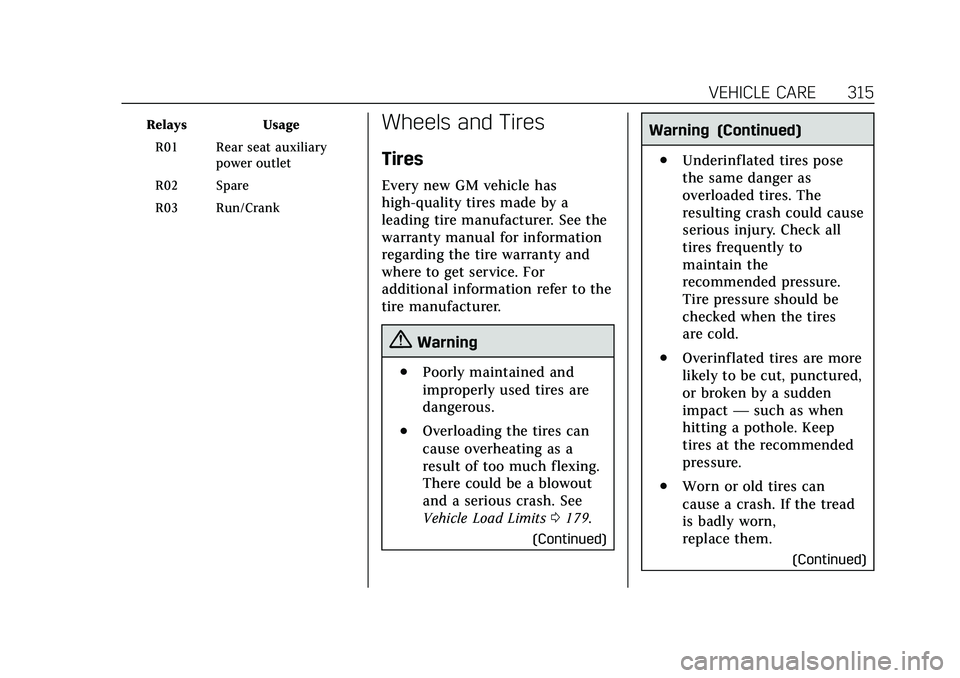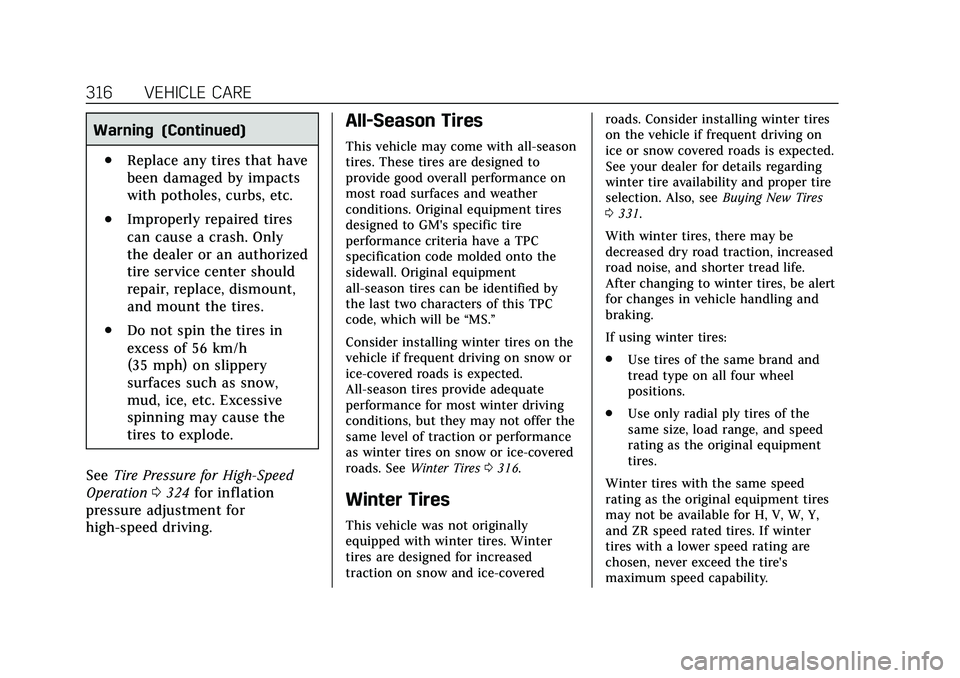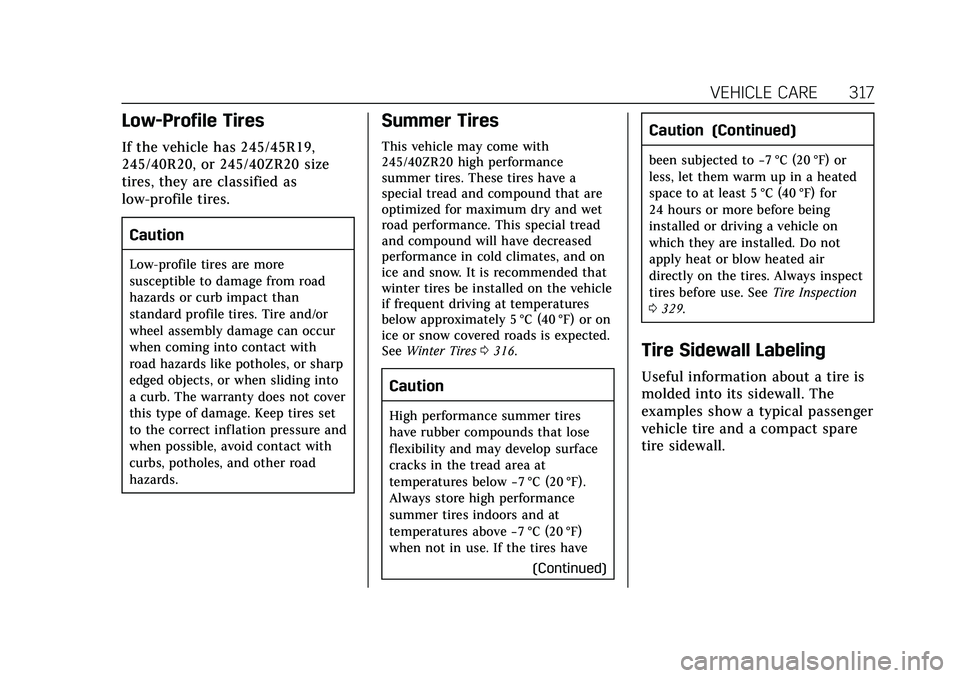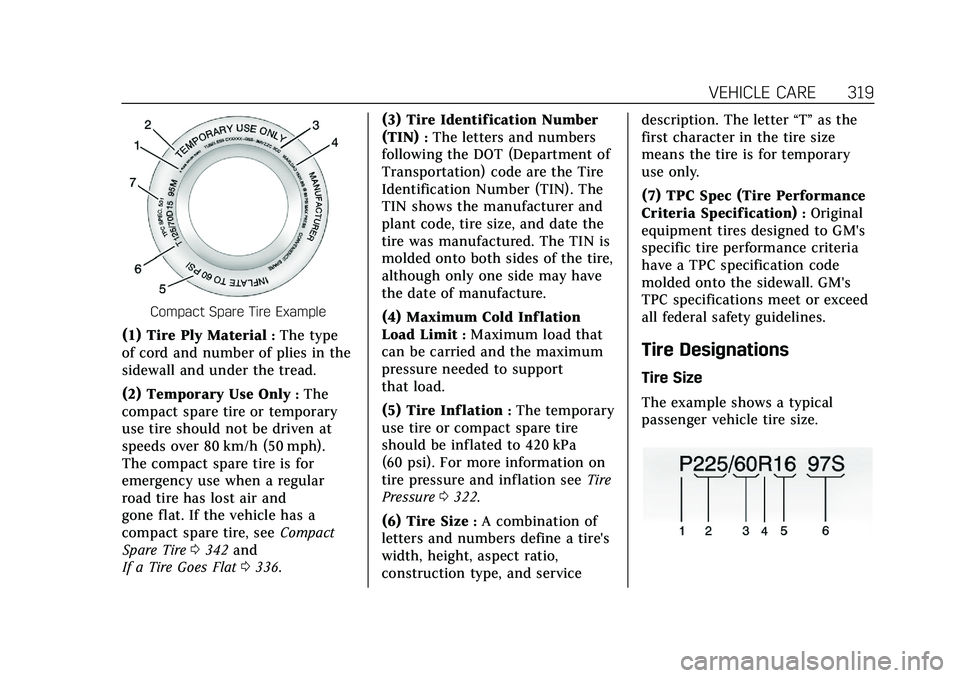CADILLAC CT6 2020 Owner's Manual
Manufacturer: CADILLAC, Model Year: 2020, Model line: CT6, Model: CADILLAC CT6 2020Pages: 412, PDF Size: 7.13 MB
Page 311 of 412

Cadillac CT6 Owner Manual (GMNA-Localizing-U.S./Canada-13566829) -
2020 - CRC - 6/11/19
310 VEHICLE CARE
FusesUsage
F22 –
F23 Rear closure latch
F24 –
F25 Left front motorized seat belt pretensioner
F26 Rear Defogger
F27 Right front subwoofer
F28 Amplifier
F29 Sunroof
F30 Body control module 2
F31 Body control module 6
F32 Exterior heated mirrors
F33 Right window
F34 Power trunk module
F35 –
F36 –
F37 – Fuses
Usage
F38 Rear blower
F39 Fuel tank zone module
F40 –
F41 Rear seat auxiliary power outlet
F42 Left rear memory seat
F43 –
F44 Rear closure release switch/Power trunk
module/Integrated
chassis control
module battery
F45 Auxiliary audio/Video
F46 External object calculating module/
Side blind zone alert/
Rear center short
range radar sensor/
Long range radar
sensors
F47 –
F48 – Fuses
Usage
F49 Memory bolster module
F50 Body control module 1
F51 Transmission control module
F52 Park assist
F53 Ventilated seats
F54 Headliner/Universal garage door opener/
Power sounder
module/Rain sensor
F55 Front memory seat module
F56 Rear HVAC Display
F57 –
F58 –
F59 Engine control module battery
F60 Right front motorized seat belt pretensioner
F61 –
Page 312 of 412

Cadillac CT6 Owner Manual (GMNA-Localizing-U.S./Canada-13566829) -
2020 - CRC - 6/11/19
VEHICLE CARE 311
FusesUsage
F62 –
F63 Rear seat infotainment module
F64 Engine control module ignition
F65 Rear window sunshade
F66 Rear vision camera/ Inside Rearview
mirror
F67 Run/Crank misc/Air quality sensor/
Integrated chassis
control module/
Electronic shifter/DC
DC converter
F68 Damping control module
F69 Television tuner module
F70 –
F71 –
F72 – Fuses
Usage
F73 –
F74 –
F75 –
Relays Usage
R1 Rear seat auxiliary power outlet
R2 Spare
R3 Run/Crank
Page 313 of 412

Cadillac CT6 Owner Manual (GMNA-Localizing-U.S./Canada-13566829) -
2020 - CRC - 6/11/19
312 VEHICLE CARE
With Super Cruise
Fuses Usage F01 –
F02 Body control module 2 and 4
F03 Left rear external object calculating
module Fuses Usage
F04 Steering wheel display/Touch sensor
F05 –
F06 – Fuses Usage
F07 Left front and right rear short range
radar sensor/Camera
image processing
module
F08 Driver memory seat module
F09 Column friction device
F10 Left headlamp
F11 –
F12 –
F13 Left front subwoofer
F14 Rear blower
F15 Left window
F16 Canister vent
F17 Rear seat memory/ Heated
F18 Rear subwoofer
F19 Damping control module
F20 –
Page 314 of 412

Cadillac CT6 Owner Manual (GMNA-Localizing-U.S./Canada-13566829) -
2020 - CRC - 6/11/19
VEHICLE CARE 313
FusesUsage
F21 Electric brake control module - 2
F22 –
F23 Left front motorized seat belt pretensioner
F24 Body control module 7
F25 Passive entry/Passive start battery
F26 Rear closure latch
F27 Amplifier
F28 Rear Defogger
F29 Park assist module
F30 Body control module 1
F31 Driver monitoring system
F32 Driver passenger door window/Mirror/
Driver seat
adjustment/Fuel door
switch Fuses
Usage
F33 Passenger/Rear seat adjustment switch
F34 Left front memory seat
F35 Right rear memory seat
F36 External heated mirror
F37 –
F38 Transmission control module
F39 Rear seat infotainment module
F40 –
F41 –
F42 –
F43 Power trunk module
F44 Right front memory seat
F45 –
F46 Right window Fuses
Usage
F47 Engine control module battery
F48 Right front subwoofer
F49 Body control module 6
F50 –
F51 –
F52 Fuel tank zone module
F53 Rear seat auxiliary power outlet
F54 Left rear memory seat
F55 –
F56 Rear closure release switch/Power trunk
module
Page 315 of 412

Cadillac CT6 Owner Manual (GMNA-Localizing-U.S./Canada-13566829) -
2020 - CRC - 6/11/19
314 VEHICLE CARE
FusesUsage
F57 Rear left and rear center short range
radar sensors/Long
range radar sensors/
Right rear external
object calculating
module
F58 Auxiliary audio/Video
F59 –
F60 Memory bolster module
F61 –
F62 Ventilated seat
F63 Universal garage door opener/Power
sounder module/Rain
sensor
F64 Passenger memory seat module
F65 Right front short range radar sensor/
Advance driver
assist map Fuses
Usage
F66 Television tuner module
F67 –
F68 –
F69 –
F70 Right front motorized seat belt pretensioner
F71 Rear heated seat module
F72 Sunroof
F73 Rear vision camera/ Inside Rearview
mirror/Air quality
sensor
F74 Rear window sunshade
F75 Engine control module ignition Fuses
Usage
F76 Misc run crank/ Energy storage
control module/DC
DC converter/Rear
external object
calculating module/
Shifter interface
board module
F77 Trunk auxiliary power outlet
F78 Rear HVAC display
F79 –
F80 –
F81 –
F82 –
F83 –
F84 –
F85 –
F86 –
F87 –
Page 316 of 412

Cadillac CT6 Owner Manual (GMNA-Localizing-U.S./Canada-13566829) -
2020 - CRC - 6/11/19
VEHICLE CARE 315
RelaysUsage
R01 Rear seat auxiliary power outlet
R02 Spare
R03 Run/CrankWheels and Tires
Tires
Every new GM vehicle has
high-quality tires made by a
leading tire manufacturer. See the
warranty manual for information
regarding the tire warranty and
where to get service. For
additional information refer to the
tire manufacturer.
{Warning
.Poorly maintained and
improperly used tires are
dangerous.
.Overloading the tires can
cause overheating as a
result of too much flexing.
There could be a blowout
and a serious crash. See
Vehicle Load Limits 0179.
(Continued)
Warning (Continued)
.Underinflated tires pose
the same danger as
overloaded tires. The
resulting crash could cause
serious injury. Check all
tires frequently to
maintain the
recommended pressure.
Tire pressure should be
checked when the tires
are cold.
.Overinflated tires are more
likely to be cut, punctured,
or broken by a sudden
impact —such as when
hitting a pothole. Keep
tires at the recommended
pressure.
.Worn or old tires can
cause a crash. If the tread
is badly worn,
replace them.
(Continued)
Page 317 of 412

Cadillac CT6 Owner Manual (GMNA-Localizing-U.S./Canada-13566829) -
2020 - CRC - 6/11/19
316 VEHICLE CARE
Warning (Continued)
.Replace any tires that have
been damaged by impacts
with potholes, curbs, etc.
.Improperly repaired tires
can cause a crash. Only
the dealer or an authorized
tire service center should
repair, replace, dismount,
and mount the tires.
.Do not spin the tires in
excess of 56 km/h
(35 mph) on slippery
surfaces such as snow,
mud, ice, etc. Excessive
spinning may cause the
tires to explode.
See Tire Pressure for High-Speed
Operation 0324 for inflation
pressure adjustment for
high-speed driving.
All-Season Tires
This vehicle may come with all-season
tires. These tires are designed to
provide good overall performance on
most road surfaces and weather
conditions. Original equipment tires
designed to GM's specific tire
performance criteria have a TPC
specification code molded onto the
sidewall. Original equipment
all-season tires can be identified by
the last two characters of this TPC
code, which will be “MS.”
Consider installing winter tires on the
vehicle if frequent driving on snow or
ice-covered roads is expected.
All-season tires provide adequate
performance for most winter driving
conditions, but they may not offer the
same level of traction or performance
as winter tires on snow or ice-covered
roads. See Winter Tires 0316.
Winter Tires
This vehicle was not originally
equipped with winter tires. Winter
tires are designed for increased
traction on snow and ice-covered roads. Consider installing winter tires
on the vehicle if frequent driving on
ice or snow covered roads is expected.
See your dealer for details regarding
winter tire availability and proper tire
selection. Also, see
Buying New Tires
0 331.
With winter tires, there may be
decreased dry road traction, increased
road noise, and shorter tread life.
After changing to winter tires, be alert
for changes in vehicle handling and
braking.
If using winter tires:
. Use tires of the same brand and
tread type on all four wheel
positions.
. Use only radial ply tires of the
same size, load range, and speed
rating as the original equipment
tires.
Winter tires with the same speed
rating as the original equipment tires
may not be available for H, V, W, Y,
and ZR speed rated tires. If winter
tires with a lower speed rating are
chosen, never exceed the tire's
maximum speed capability.
Page 318 of 412

Cadillac CT6 Owner Manual (GMNA-Localizing-U.S./Canada-13566829) -
2020 - CRC - 6/11/19
VEHICLE CARE 317
Low-Profile Tires
If the vehicle has 245/45R19,
245/40R20, or 245/40ZR20 size
tires, they are classified as
low-profile tires.Caution
Low-profile tires are more
susceptible to damage from road
hazards or curb impact than
standard profile tires. Tire and/or
wheel assembly damage can occur
when coming into contact with
road hazards like potholes, or sharp
edged objects, or when sliding into
a curb. The warranty does not cover
this type of damage. Keep tires set
to the correct inflation pressure and
when possible, avoid contact with
curbs, potholes, and other road
hazards.
Summer Tires
This vehicle may come with
245/40ZR20 high performance
summer tires. These tires have a
special tread and compound that are
optimized for maximum dry and wet
road performance. This special tread
and compound will have decreased
performance in cold climates, and on
ice and snow. It is recommended that
winter tires be installed on the vehicle
if frequent driving at temperatures
below approximately 5 °C (40 °F) or on
ice or snow covered roads is expected.
See Winter Tires 0316.
Caution
High performance summer tires
have rubber compounds that lose
flexibility and may develop surface
cracks in the tread area at
temperatures below −7 °C (20 °F).
Always store high performance
summer tires indoors and at
temperatures above −7 °C (20 °F)
when not in use. If the tires have
(Continued)
Caution (Continued)
been subjected to−7 °C (20 °F) or
less, let them warm up in a heated
space to at least 5 °C (40 °F) for
24 hours or more before being
installed or driving a vehicle on
which they are installed. Do not
apply heat or blow heated air
directly on the tires. Always inspect
tires before use. See Tire Inspection
0 329.
Tire Sidewall Labeling
Useful information about a tire is
molded into its sidewall. The
examples show a typical passenger
vehicle tire and a compact spare
tire sidewall.
Page 319 of 412

Cadillac CT6 Owner Manual (GMNA-Localizing-U.S./Canada-13566829) -
2020 - CRC - 6/11/19
318 VEHICLE CARE
Passenger (P-Metric) Tire Example
(1) Tire Size:The tire size is a
combination of letters and
numbers used to define a
particular tire's width, height,
aspect ratio, construction type,
and service description. See the
“Tire Size ”illustration later in this
section.
(2) TPC Spec (Tire Performance
Criteria Specification)
:Original
equipment tires designed to GM's
specific tire performance criteria
have a TPC specification code molded onto the sidewall. GM's
TPC specifications meet or exceed
all federal safety guidelines.
(3) DOT (Department of
Transportation)
:The
Department of Transportation
(DOT) code indicates that the tire
is in compliance with the U.S.
Department of Transportation
Motor Vehicle Safety Standards.
DOT Tire Date of Manufacture
:
The last four digits of the TIN
indicate the tire manufactured
date. The first two digits represent
the week (01–52) and the last two
digits, the year. For example, the
third week of the year 2010 would
have a four-digit DOT date
of 0310.
(4) Tire Identification Number
(TIN)
:The letters and numbers
following the DOT (Department of
Transportation) code are the Tire
Identification Number (TIN). The
TIN shows the manufacturer and
plant code, tire size, and date the tire was manufactured. The TIN is
molded onto both sides of the tire,
although only one side may have
the date of manufacture.
(5) Tire Ply Material
:The type
of cord and number of plies in the
sidewall and under the tread.
(6) Uniform Tire Quality
Grading (UTQG)
:Tire
manufacturers are required to
grade tires based on three
performance factors: treadwear,
traction, and temperature
resistance. For more information
see Uniform Tire Quality Grading
0 333.
(7) Maximum Cold Inf lation
Load Limit
:Maximum load that
can be carried and the maximum
pressure needed to support
that load.
Page 320 of 412

Cadillac CT6 Owner Manual (GMNA-Localizing-U.S./Canada-13566829) -
2020 - CRC - 6/11/19
VEHICLE CARE 319
Compact Spare Tire Example
(1) Tire Ply Material:The type
of cord and number of plies in the
sidewall and under the tread.
(2) Temporary Use Only
:The
compact spare tire or temporary
use tire should not be driven at
speeds over 80 km/h (50 mph).
The compact spare tire is for
emergency use when a regular
road tire has lost air and
gone flat. If the vehicle has a
compact spare tire, see Compact
Spare Tire 0342 and
If a Tire Goes Flat 0336. (3) Tire Identification Number
(TIN)
:The letters and numbers
following the DOT (Department of
Transportation) code are the Tire
Identification Number (TIN). The
TIN shows the manufacturer and
plant code, tire size, and date the
tire was manufactured. The TIN is
molded onto both sides of the tire,
although only one side may have
the date of manufacture.
(4) Maximum Cold Inf lation
Load Limit
:Maximum load that
can be carried and the maximum
pressure needed to support
that load.
(5) Tire Inf lation
:The temporary
use tire or compact spare tire
should be inflated to 420 kPa
(60 psi). For more information on
tire pressure and inflation see Tire
Pressure 0322.
(6) Tire Size
:A combination of
letters and numbers define a tire's
width, height, aspect ratio,
construction type, and service description. The letter
“T”as the
first character in the tire size
means the tire is for temporary
use only.
(7) TPC Spec (Tire Performance
Criteria Specification)
:Original
equipment tires designed to GM's
specific tire performance criteria
have a TPC specification code
molded onto the sidewall. GM's
TPC specifications meet or exceed
all federal safety guidelines.
Tire Designations
Tire Size
The example shows a typical
passenger vehicle tire size.